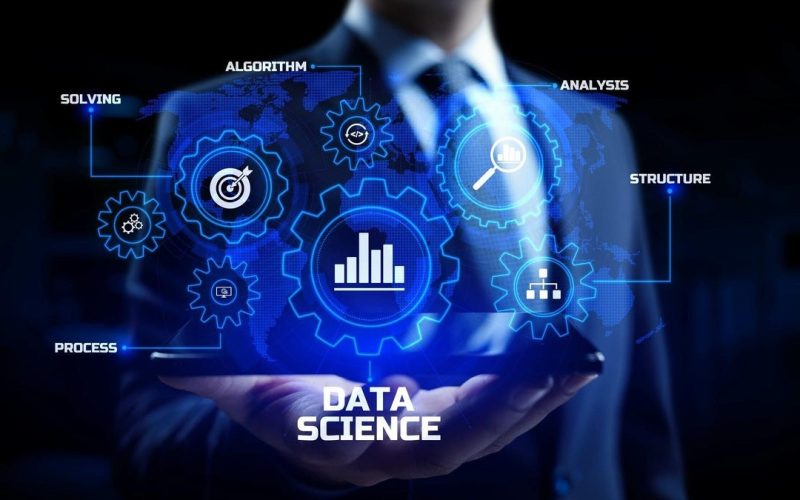Introduction
Data science approaches are used to create intelligent systems that turn unprocessed information into meaningful insights. Using mathematical models and computer techniques, they discover patterns and produce projections. Model optimization methods increase the accuracy, speed, and dependability of these algorithms. Together, they help companies to properly forecast results and make decisions based on data. Combining strong algorithms with optimization methods ensures better analytics and continuous development in artificial intelligence and machine learning systems in the digital age of today. Acquire hands-on experience from industry experts by registering in Data Science Coaching in Hyderabad.
What Are Data Science Algorithms?
Data science algorithms are mathematical instructions that allow computers to analyze data and make sense of it. These algorithms can find relationships, identify patterns, and make predictions based on previous information.
They can be broadly divided into three main categories:
- Supervised Learning Algorithms: These algorithms are trained using labeled data, meaning that both the input and output are known. The model learns from this data to predict future outcomes. Examples include linear regression and decision trees.
- Unsupervised Learning Algorithms: These algorithms work with unlabeled data. They find hidden structures or patterns in data without predefined outputs. Examples include clustering algorithms like K-Means and dimensionality reduction techniques like PCA (Principal Component Analysis).
- Reinforcement Learning Algorithms: These algorithms learn through trial and error, improving their performance based on rewards or penalties. They are commonly used in robotics, gaming, and self-driving cars.
Each type of algorithm serves a specific purpose, and selecting the right one depends on the problem you want to solve.
Data Science Algorithms and Model Optimization Techniques
Modern intelligent systems depend on data science algorithms. These algorithms convert unprocessed data into insightful observations. Clear grasp of mathematics, computer science, and statistics is needed for the procedure. Model optimization methods increase the correctness and performance of these algorithms. Working together, they enable companies to be more informed, anticipate results, and get a competitive advantage in their respective fields.
Understanding Data Science Algorithms
Data science algorithms find patterns and correlations in enormous datasets. Mathematical functions help them to map input data to anticipated output values. The most prevalent algorithms in this field are machine learning ones. They comprise unsupervised, supervised, and reinforcement learning techniques. Supervised learning methods forecast results from labelled data. Linear regression, decision trees, and support vector machines are some examples. Unsupervised algorithms find latent patterns in data without given labels. K-means and Apriori are among such methods. Reinforcement learning instructs systems to base choices on rewards and punishments.
Role of Regression and Classification
Continuous values like stock prices or sales forecasts are estimated by regression algorithms. Between variables, linear regression produces a straight-line connection. Though it is named, logistic regression is a classifying method. It forecasts the chance of an event—that a consumer would purchase a product, for instance. Classification algorithms classify categorical data and decide to which class a data point belongs. Among others include decision trees, random forests, and gradient boosting. Email spam detection, credit scoring, and medical diagnosis all benefit from these algorithms.
Commonly Used Data Science Algorithms
Let’s take a closer look at some of the most widely used algorithms in data science and machine learning.
1. Linear Regression
Linear regression is one of the simplest and most commonly used algorithms. It finds a straight-line relationship between input variables (features) and an output variable. It’s ideal for predicting numerical values such as sales forecasts, temperature predictions, or housing prices.
2. Logistic Regression
Despite its name, logistic regression is used for classification problems, not regression. It predicts probabilities and is often used for binary classification, such as determining whether an email is spam or not.
3. Decision Trees
Decision trees split data into smaller subsets based on specific conditions, forming a tree-like structure. They are easy to understand and visualize, making them popular for both classification and regression problems.
4. Random Forest
A random forest is an ensemble of multiple decision trees. It combines the results of many trees to make more accurate predictions and reduce overfitting. This algorithm is widely used in industries such as healthcare, finance, and marketing.
5. Support Vector Machines (SVM)
SVM is a powerful algorithm used for classification and regression tasks. It finds the best line (or boundary) that separates data points into different categories. It’s especially useful for image recognition and text classification.
6. K-Means Clustering
K-Means is an unsupervised learning algorithm that groups data into clusters based on similarities. It’s commonly used for customer segmentation, image compression, and pattern recognition.
7. Neural Networks and Deep Learning
Neural networks are inspired by the human brain and are designed to recognize patterns in data. They are the foundation of deep learning, which powers technologies like voice assistants, facial recognition, and self-driving vehicles.
The Importance of Model Optimization
Building a machine learning model is only the first step. The real challenge lies in improving its performance. This is where model optimization techniques come into play.
Model optimization focuses on fine-tuning algorithms to make them faster, more accurate, and more efficient. The goal is to reduce errors and ensure that the model performs well on new, unseen data.
Without proper optimization, even the most advanced algorithm can produce inaccurate or biased results.
Clustering and Dimensionality Reduction
Clustering techniques group data points with similar characteristics. Data are sorted into K clusters depending on distance from the centroid by K-means clustering. Hierarchical clustering produces nested clusters providing more structural information. Dimensionality reduction methods simplify data while keeping its meaning. Principal Component Analysis (PCA) transforms features into smaller sets of uncorrelated components, hence lowering dimensionality. Overfitting is avoided in this phase, which also speeds processing. Master cutting-edge algorithms and model optimization approaches for practical uses by enrolling in the Data Science Course in Jaipur.
Model Optimization in Data Science
Model optimization guarantees that algorithms provide dependable outcomes and run quickly. It entails tweaking model construction and parameters. Hyper-parameter tuning is a crucial process. It chooses the ideal mix of variables affecting the learning process. Common approaches are Bayesian optimization, random search, and grid search. By including penalties to large data, regularizing techniques like Lasso and Ridge stop overfitting. coefficients. Cross-validation checks model performance on several subsets of data to confirm generalization.
Advanced Optimization Techniques
The most often utilized optimization technique in machine learning is gradient descent. By repeatedly modifying coefficients in the direction of the steepest descent, it reduces the cost function. Varieties like stochastic gradient descent and mini-batch gradient descent trade speed against accuracy. Early termination stops training when additional progress is not great. bagging and boosting are ensemble approaches that combine several models to raise accuracy. Faster computation and greater accuracy justify the use of approaches such as XGBoost and LightGBM.
Importance of Evaluation Metrics
Without performance evaluation, model optimization is partial. Performance of classifications is measured using metrics including accuracy, precision, recall, and F1-score. Mean squared error and R-squared values guide regression models; confusion matrices show prediction mistakes and so help to show the model’s strengths and limitations. These indicators aid in adjusting models for superior outcomes.
| Category | Algorithm / Technique | Purpose | Key Features | Common Use Cases |
| Supervised Learning | Linear Regression | Predict continuous values | Simple, interpretable, efficient | Sales forecasting, pricing models |
| Supervised Learning | Logistic Regression | Classify binary outcomes | Probabilistic output, fast to train | Fraud detection, medical diagnosis |
| Supervised Learning | Decision Tree | Predict categorical or continuous targets | Visual and easy to understand | Customer segmentation, risk analysis |
| Supervised Learning | Random Forest | Combine multiple decision trees | Reduces overfitting, improves accuracy | Credit scoring, feature importance |
| Unsupervised Learning | K-Means Clustering | Group similar data points | Centroid-based clustering | Market segmentation, image compression |
| Unsupervised Learning | Hierarchical Clustering | Build nested data clusters | Dendrogram visualization | Gene expression analysis, document grouping |
| Dimensionality Reduction | Principal Component Analysis (PCA) | Reduce data dimensions | Maintains most variance | Image processing, feature selection |
| Optimization Technique | Gradient Descent | Minimize loss function | Iterative parameter adjustment | Neural network training, regression models |
| Optimization Technique | Regularization (Lasso, Ridge) | Prevent overfitting | Adds penalty to large coefficients | Regression models, feature selection |
| Optimization Technique | Cross-Validation | Validate model performance | Tests on multiple data subsets | Model evaluation, overfitting detection |
| Optimization Technique | Hyperparameter Tuning (Grid/Random Search) | Find best parameter combination | Systematic or random exploration | Machine learning model improvement |
| Ensemble Method | Boosting (XGBoost, LightGBM) | Combine weak models | High accuracy, handles imbalance | Predictive analytics, competitions |
Challenges in Model Optimization
While optimization can improve performance, it also presents some challenges.
- Computational Cost: Fine-tuning large models can require significant time and processing power.
- Overfitting Risk: Over-optimizing for training data can reduce performance on new data.
- Data Quality: No amount of optimization can fix poor-quality or biased data.
The key is to strike a balance between accuracy, efficiency, and generalization.
Real-World Applications of Optimized Models
Optimized data science models are used across multiple industries:
- Healthcare: Predicting diseases, analyzing medical images, and personalizing treatment plans.
- Finance: Detecting fraud, assessing credit risk, and forecasting stock prices.
- Retail: Understanding consumer behavior and optimizing inventory.
- Transportation: Improving logistics, traffic predictions, and self-driving technology.
Optimized algorithms help businesses save time, reduce costs, and make better decisions based on accurate insights.
Conclusion
For creating clever systems, algorithms for data science and optimizing methods are essential. Pick the Best Data Science Course in Delhi to lay a solid foundation in analytics and advance your career in data-driven sectors. Though optimization enhances stability and accuracy, algorithms draw knowledge from complex data. Regression, classification, clustering, and gradient-based methods work together to stimulate creativity across sectors. Companies use these systems to forecast trends and automate decisions. As the complexity of data grows, so will the worth of optimization. Smarter algorithms and effective model refinement techniques that guarantee reliability and performance will determine the future of Data Science.










